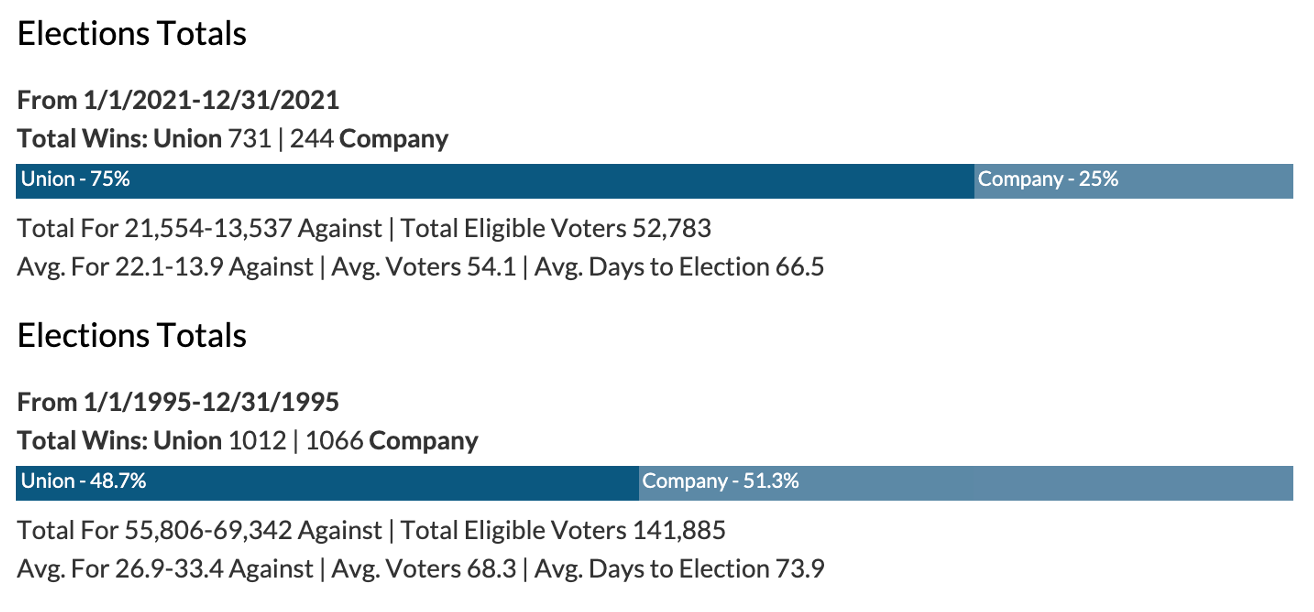The union membership numbers are out, and for Big Labor they’re awful. Total union membership dropped to 10.3%, tying a record low. And private sector membership fell to 6.1% which sets a new record low.
You may be asking how is this possible? After all the pixels spilled last year about the huge resurgence of unions and employee activism how did membership drop? Here’s how former NLRB Chair Wilma Liebman put it in the Bloomberg piece:
“There’s no denying that there has been an upsurge in worker activism over the last few years, and it’s obvious that large numbers of workers are fed up, and the conditions of the pandemic just aggravated it. But it’s not translating into increased numbers for unions.”
This is obviously correct, but the bigger question is why isn’t it translating? Liebman and others will quickly point to anti-union activities of management. Even when employees file a petition with the NLRB they are forced into “captive audience” meetings (a.k.a. an employee meeting, just like the ones you are asked to attend many times each week at wherever you work, union or non-union).
Rest assured that this will be the repeated narrative over the next few years. Any company who has the audacity to speak to employees about how unions work or employee rights under the Act, will be branded a union-buster. And God forbid you hire a law firm or consulting firm who actually knows this arcane area of law and can explain it.
This narrative is so easily disproven. Take a look at these two charts from LRIrightnow:

Last year unions won 75% of all elections held, tying the top win rate since we’ve been tracking. In 1995 unions won only 49% of elections. Management campaign activities are supposedly so out of hand that a free and fair election is impossible – yet unions keep increasing their win percentage year after year. How can those two things be true at the same time? The answer is obvious, they can’t.
Instead, the problem is the same problem it’s been for decades: unions just don’t deliver what they promise. And once employees understand that they just aren’t interested in organizing. The BLS explains part of the problem in its press release on the new numbers:
“Union membership data for 2021 continue to reflect the impact on the labor market of the coronavirus (COVID-19) pandemic. Comparisons with union membership measures for 2020, including metrics such as the union membership rate and median usual weekly earnings, should be interpreted with caution. The onset of the pandemic in 2020 led to an increase in the unionization rate due to a disproportionately large decline in the number of nonunion workers compared with the decline in the number of union members. The decrease in the rate in 2021 reflects a large gain in the number of nonunion workers and a decrease in the number of union workers.”
Basically, the release is saying that during the great resignation of 2021, a lot of union members chose to move out of union jobs and into non-union ones.
Hold on, you might ask, don’t union members make a lot more money than non-union workers? The BLS release suggests union members make nearly $200 per week more than non-union ones. But even BLS explains its number must be taken with a grain of salt. They don’t account for differences in industry or geography, for example.
A better way to look at these numbers is using census data from the Current Population Survey and the best place to see that is at Barry Hirsch and David Macpherson’s Unionstats.com. Here you can drill down to wage differences by industry, for example. Look at manufacturing and retail. The 2020 numbers show that non-union retail workers make $1.97 per hour more than union members. And that is before dues. If you figure dues at 1.5% of pay (they can be less or more, but that’s a good average) the wage gap grows to $2.27 per hour, or more than $4,700 per year.
Non-union manufacturing workers make $3.52 per hour more than union members. If you deduct union dues the manufacturing union represented wage gap grows to $3.95 per hour, or more than $8,200 per year!
And as BLS states, this isn’t accounting for factors like unionized workers are more likely to live in high cost of living areas (the highest union densities are in places like New York, California, and Hawaii). This skews the union wages higher than they would be if you are comparing similarly situated workers.
The bottom line is that unions don’t deliver what they promise. And while worker leverage has never been higher, using that leverage has never required a union. It looks like today’s workers understand that. While they like the idea of a union, once they get into the actual mechanics of turning over their voice and power to one, it seems pretty antiquated. It seems that way because it is.




